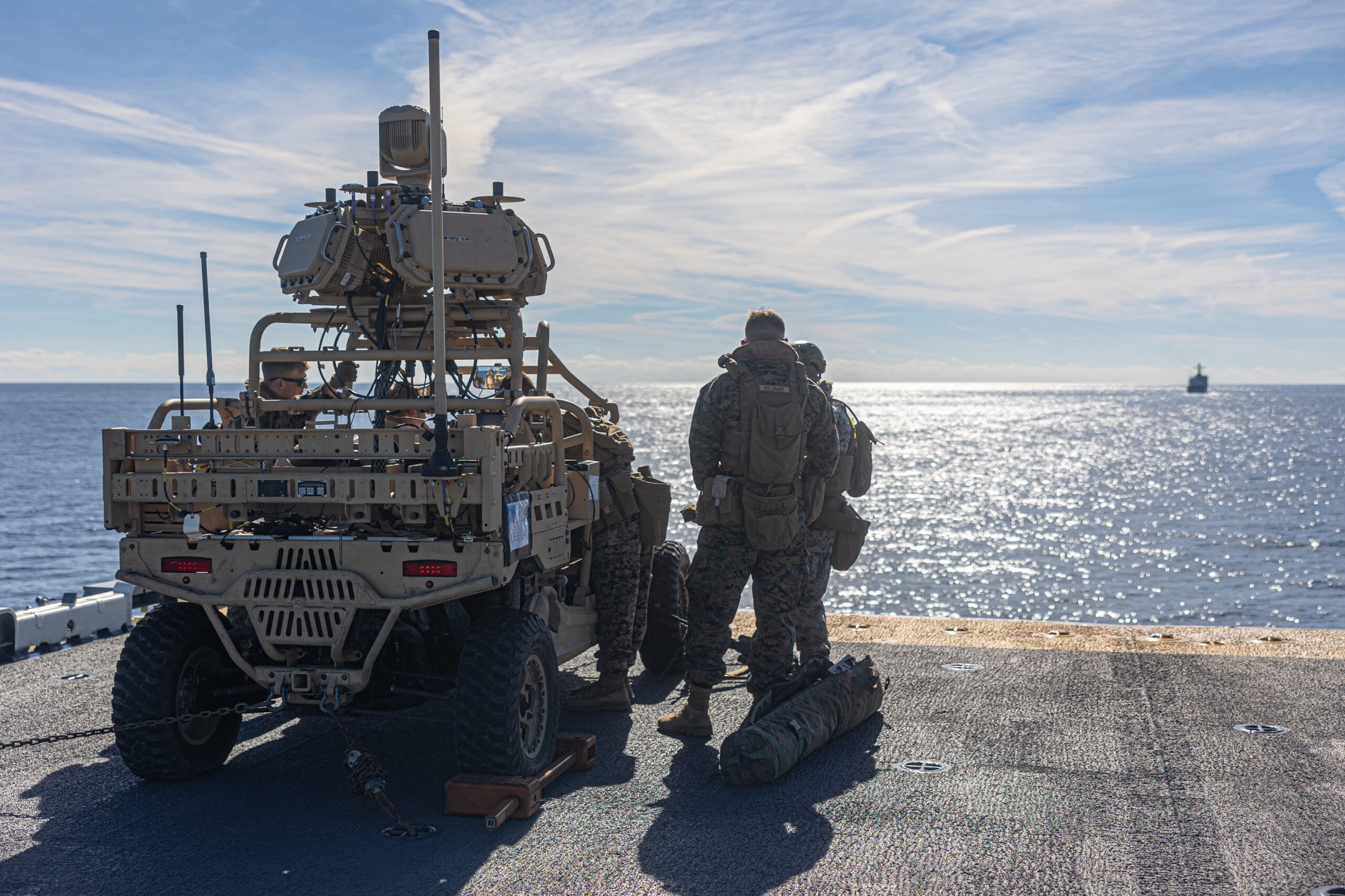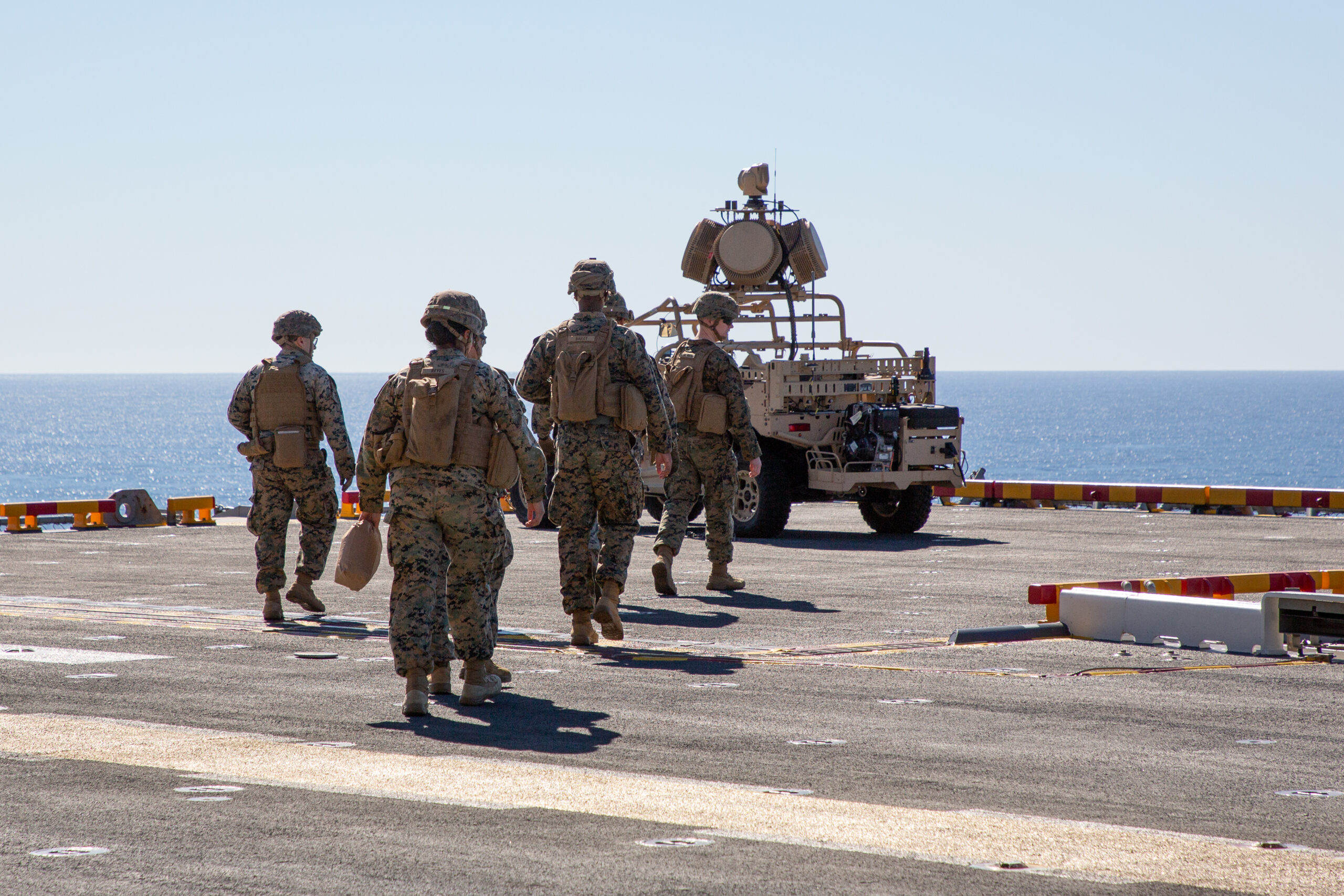
Ground forces and military installations face many threats, with two, in particular, at the top of the list. The first is the threat from ballistic missiles such as those launched at US forces in western Iraq by Iran in 2020. The second is the danger of rockets, cruise missiles, and drones targeted against bases and mobile operations.
To deal with the threat of ballistic missiles, the Army and others have installed large, logistics-heavy but also very effective air-and-missile-defense systems like Patriot to protect bases and installations.
To counter the other threats, the Defense Department counts on continued development of small, affordable, upgradeable hemispheric radars for both perimeter security and vehicle-mounted protection for mobile forces.
It’s the second threat where a company like Leonardo DRS steps in, supplying warfighters with a family of radars that play important roles in the development of a layered, resilient architecture for air and missile defense.
For example, The Leonardo DRS business unit, DRS RADA, develops a family of advanced radars are the system-of-choice for the Army’s Stryker-based Mobile Short-Range Air Defense (M-SHORAD) system that provide enhanced fire control and air surveillance capabilities to detect and track all incoming threats. The Army is in the process of procuring up to 162 M-SHORAD systems. The company’s radar is also on the next phase of the Army’s experimental directed-energy DE M-SHORAD laser weapon.
Similarly, the Marine Corps’ Joint Light Tactical Vehicle (JLTV)-based Marine Air Defense Integrated System (MADIS) program, as well as the MRZR-based Light-MADIS, include DRS RADA’s Counter-Unmanned Aircraft Systems (C-UAS) technology. MADIS is now transitioning from an “urgent need” to a program of record, reports Breaking Defense.

The DRS RADA hemispheric radar lineup
The Army and Marine Corps counter-UAS, Counter-Rocket, Artillery, and Mortar (C-RAM), and M-SHORAD programs are made possible by DRS RADA’s family of Multi-Mission Hemispheric Radars (MHR). The term “hemispheric” means that they all provide 360-degree radar coverage to detect and track the threats mentioned earlier, plus fixed-wing and rotary craft. They include the following.MHR—This ground-based, multi-mission, pulse-Doppler, software-defined, S-band radar incorporates an active electronically scanned array (AESA) antenna and Gallium nitride (GaN) amplifiers with advanced 4D processing capabilities, providing unprecedented clutter handling and multipath mitigation.
- The MHR and the following variants are best-of-class radars with exceptional hemispheric surveillance for situational awareness and survivability during combat. They offer a superior size, weight, power, and cost (SWaP-C) profile that facilitates on-the-move operations.
- nMHR (Next-Gen MHR)—This pulse-Doppler, software-defined, X-band radar platform incorporates an AESA antenna, GaN amplifiers, and a wide instantaneous frequency band with the capabilities of MHR plus unprecedented accuracies and target resolution.
- ieMHR (Improved & Enhanced MHR)—This pulse-Doppler, software-defined, S-band radar platform also incorporates an AESA antenna and GaN amplifiers with 4D processing capabilities and offers outstanding range for a highly portable radar.
- exMHR (Enhanced & Extended MHR)—The exMHR is a ground-based, multi-mission radar for C-UAS, VSHORAD, C-RAM, as well as fire control and hemispheric surveillance. The pulse-Doppler, software-defined, S-band AESA radar offers fire-control tracking accuracy, as well as clutter handling and multipath mitigation. One of DRS RADA’s largest mobile radars, it’s designed to counter cruise missile threats like those seen now in Ukraine.
- aCHR (Advanced Compact Hemispheric Radar)—A ground-based, pulse-Doppler, software-defined, S-band AESA antenna with GaN amplifiers radar for Active Protection Systems (APS), Vehicle Protection Systems (VPS), Hostile Fire Detection (HFD),C-UAS, and hemispheric surveillance on mobile platforms like Stryker and JLTV.
Low SWaP-C for the expeditionary radar
Notice the commonality within that family of radars? They’re all AESA radars, which means they employ the world’s most advanced radar technology.
“They all use the gallium nitride chemistry in the semiconductors, so they run as cool and as fast as the current state of the art for radar technology,” said Joseph Mollo, director of Business Development Advanced Programs at DRS RADA, adding that they all have a common software baseline.
“A common software architecture enables the fast development of new capabilities. Say we add advanced filtering to mitigate multipath or if there’s a new electronic warfare threat that we’re concerned about, we can generate a change to the radars in software that will propagate across the entire portfolio of products. It allows us to do things quickly, efficiently, and affordably.”
The compact aCHR, in particular, because of its low SWaP-C is designed for mounting directly to vehicles for use in active protection systems mentioned earlier. An aCHR variant, the Enhanced Compact Hemispheric Radar (eCHR), is employed by the Marine Corps on the MADIS and L-MADIS programs.
“One of the fundamental principles that we at DRS RADA have focused on and that has made us successful is the SWaP-C of the expeditionary radar,” continued Mollo. “We’ve adopted an approach in all of our architectures that leverages commercial technology. We don’t have any custom foundry items in our radars. That allows us to drive the cost down significantly. At the same time, to keep it expeditionary, we don’t have anything that needs external cooling. Most of our systems operate with onboard vehicle power.
“Our approach has been that if you have a network of smaller sensors, you actually have better effective coverage in your view of the battlespace. You eliminate single points of failure, which large radars present because they’re a very big target.”
Building the distributed sensor network
The vulnerability of large emitters on the battlefield goes to the heart of what DRS RADA calls the Army/Marine Corps distributed sensor network. This consists of larger radars for systems like Patriot and the Marines’ G/ATOR (Ground/Air Task Oriented Radar) and smaller ones like the MHR line for mobile-and-perimeter support roles.
“We’re learning as a nation that while the large sensor technology is vitally needed and not going to go away, the distributed sensor network is also important to complement the national-asset radars with forward, highly mobile, expeditionary radars,” said Mollo. “Maybe you want to have different sensors that look at things a bit differently, deploy differently, and have frequency diversity. DRS RADA is pushing that envelope.”
Today’s threat profile driving the development of hemispheric radars is seen daily in actual battlefield situations in Ukraine, in that these smaller, highly mobile radars have strength in numbers. They are emitters on the battlefield and when one is taken out — because systems that emit are targeted — there are many others to compensate.
“A $40 million radar is difficult to transport and takes days to move and set up; you’re going to be very careful about how often and where you light that up,” noted Mollo. “With DRS RADA radars, they give you good performance, certainly not the capability that say a G/ATOR would provide, but they are transportable by a single C-130 and very mobile once deployed. They can roll off and 10 minutes later they’re up and running and operating on the move. That’s what we’re seeing as the future for radars on the battlefield.”
What can AI/ML do for radars?
Lots, apparently, and DRS RADA notes two applications in particular that it’s working on.
First, birds are a problem in the C-UAS mission. Things that fly fast with a ballistic trajectory aren’t going to be confused with birds, however, Class I UAS are almost identical in size to birds.
“They even have identical behaviors, in some cases,” said Mollo. “We’re developing machine learning techniques so operators don’t have to determine which they’re seeing. ML evaluates a wide range of factors, including micro-Doppler of the propeller, the speed, maneuverability, RCS, etc., to classify the target , and has shown remarkable success in providing operators with a clear air picture.”
The second area is an Army/DRS RADA program to develop a low-cost radar system that’s highly portable, as opposed to maneuverable. By portable, that means it can be carried on a roof rack and moved from one vehicle to another as operational needs dictate. All it needs externally is power from the vehicle.
The need for something like this was initially seen in the Nagorno-Karabakh War over disputed territory in Azerbaijan in the early 1990s when supply vehicles and convoys were being attacked. The idea is to affix the radar to the top of a tanker or logistics vehicle, where it would provide the driver with situational awareness.
“One of the key attributes of the system is that it doesn’t require a radar operator or an air defender. This can be mounted to any vehicle, say a resupply vehicle, and it’s there to protect the driver, his crew, and the immediate convoy.” said Mollo. “AI/ML enables the radar to make the determination about whether an observation is a potential threat about to attack, is surveilling you, or is just something that happens to be in the air. We’re using machine-learning techniques to look at the behavior of this object and, based on kinematics, determine if it is a threat or not. This is also showing great success and could be a game-changer for force protection.”
DRS RADA radars are built in the US
Finally, it’s worth noting that DRS RADA builds these radars in Germantown, MD, and plays a specialized role as a member of the US industrial base supporting warfighters and jobs in Maryland.
“Sensors — radars specifically — are very sensitive technology,” said Mollo. “A force can only defend itself as far as it can see. If your enemy knows your capabilities, you’ve lost your advantage.”
That makes it extremely important to the DoD, Mollonotes, that the core essence of technologies such as the source code built into the radars it procures resides in the US. That’s always been the case for DRS RADA, a pioneer of combat-proven, multi-mission software-defined radars for enhanced survivability of on-the-move operations.
No comments:
Post a Comment